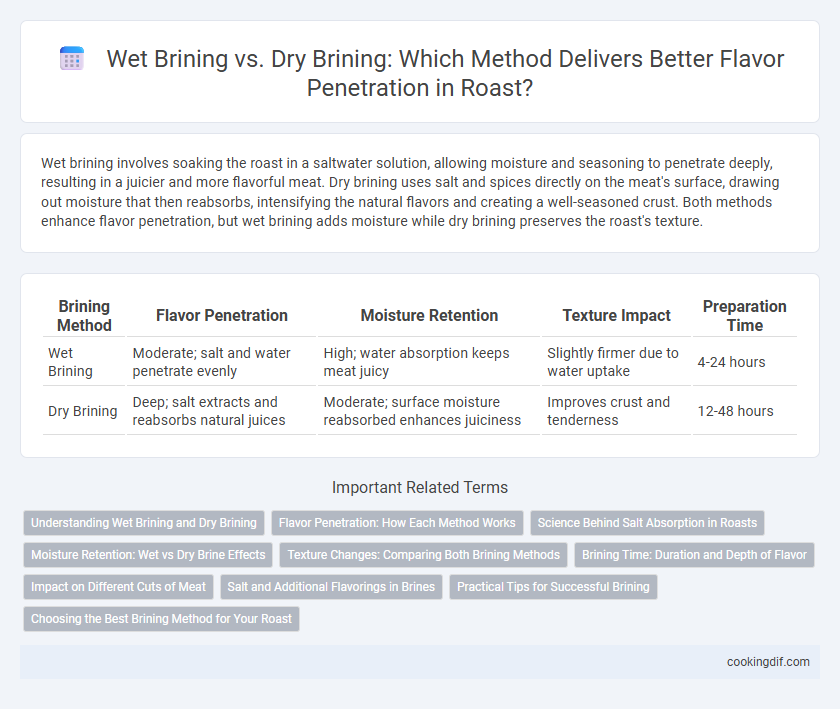Wet brining involves soaking the roast in a saltwater solution, allowing moisture and seasoning to penetrate deeply, resulting in a juicier and more flavorful meat. Dry brining uses salt and spices directly on the meat's surface, drawing out moisture that then reabsorbs, intensifying the natural flavors and creating a well-seasoned crust. Both methods enhance flavor penetration, but wet brining adds moisture while dry brining preserves the roast's texture.
Table of Comparison
| Brining Method | Flavor Penetration | Moisture Retention | Texture Impact | Preparation Time |
|---|---|---|---|---|
| Wet Brining | Moderate; salt and water penetrate evenly | High; water absorption keeps meat juicy | Slightly firmer due to water uptake | 4-24 hours |
| Dry Brining | Deep; salt extracts and reabsorbs natural juices | Moderate; surface moisture reabsorbed enhances juiciness | Improves crust and tenderness | 12-48 hours |
Understanding Wet Brining and Dry Brining
Wet brining involves submerging the roast in a saltwater solution, allowing moisture and flavors to deeply penetrate the meat through osmosis, resulting in a juicier and more flavorful roast. Dry brining, on the other hand, uses a coarse salt rub applied directly to the roast's surface, drawing out moisture and then reabsorbing it along with the salt, which enhances natural meat flavors and improves texture without added water. Both methods optimize flavor penetration, but wet brining is ideal for larger roasts needing moisture retention, while dry brining preserves the roast's natural texture and concentrates its seasoning.
Flavor Penetration: How Each Method Works
Wet brining infuses moisture and salt into the roast by submerging it in a saltwater solution, allowing flavors to penetrate deeply through osmosis. Dry brining relies on applying salt directly to the surface, which draws out moisture that then reabsorbs, intensifying flavor and improving texture. Both methods enhance flavor penetration, but wet brining can lead to juicier meat while dry brining often results in a more concentrated, savory crust.
Science Behind Salt Absorption in Roasts
Salt absorption in wet brining occurs through osmosis, where the meat draws in a saltwater solution, hydrating muscle fibers and enhancing juiciness. Dry brining relies on salt drawing moisture out, which then dissolves the salt and reabsorbs into the meat, intensifying flavor and improving texture. The ionic interaction of salt with muscle proteins denatures them, allowing deeper marinade penetration and improved moisture retention during roasting.
Moisture Retention: Wet vs Dry Brine Effects
Wet brining involves submerging the roast in a saltwater solution, enhancing moisture retention by allowing salt and water to penetrate the meat, resulting in a juicier texture. Dry brining applies salt directly on the surface, drawing out juices that then reabsorb, intensifying flavor while maintaining moisture without excess water. Moisture retention typically favors wet brining for larger cuts, whereas dry brining offers concentrated flavor with controlled moisture for smaller roasts.
Texture Changes: Comparing Both Brining Methods
Wet brining enhances moisture retention through saltwater absorption, resulting in a juicier roast with a slightly softer texture. Dry brining draws out natural juices initially, then reabsorbs them concentrated with salt, leading to a firmer, more intensely flavored crust. Both methods improve tenderness, but wet brining yields a more uniform texture while dry brining creates a distinctive, crispy exterior.
Brining Time: Duration and Depth of Flavor
Wet brining requires soaking the roast in a saltwater solution for several hours, typically 4 to 12, allowing salt and flavors to penetrate deeply and evenly throughout the meat. Dry brining, which involves rubbing the roast with salt and resting it uncovered, usually needs at least 24 hours for optimal moisture retention and intense flavor infusion. Longer brining times in both methods enhance flavor depth, but dry brining's extended duration can result in a firmer texture and more concentrated taste.
Impact on Different Cuts of Meat
Wet brining infuses moisture and salt evenly, enhancing juiciness in lean cuts like turkey breast and pork loin. Dry brining intensifies flavor by drawing out moisture and allowing salt to penetrate deeply, ideal for fattier meats such as beef roast and chicken thighs. The choice between wet and dry brining significantly impacts tenderness and flavor absorption depending on the meat's fat content and cut thickness.
Salt and Additional Flavorings in Brines
Wet brining uses a saltwater solution that penetrates meat more quickly, allowing salt and additional flavorings like herbs, garlic, and spices to evenly distribute and enhance moisture retention. Dry brining involves rubbing salt and seasonings directly onto the meat's surface, which draws out juices that reabsorb, intensifying flavor and creating a concentrated, savory crust. Both methods use salt to break down proteins and improve tenderness, but wet brines offer deeper flavor infusion while dry brines provide a more pronounced exterior seasoning.
Practical Tips for Successful Brining
Wet brining infuses meat with moisture and seasoning through a saltwater solution, ensuring juiciness and enhanced flavor penetration, best achieved by using a ratio of 1 cup kosher salt per gallon of water and brining for 1 hour per pound of meat. Dry brining, which involves rubbing salt and spices directly onto the meat's surface, intensifies flavor by drawing out moisture that then reabsorbs, creating a concentrated seasoning effect, ideal when brined for at least 24 hours in the refrigerator. For optimal results, rinse wet-brined meat before cooking to avoid excess saltiness, and allow dry-brined meat to rest uncovered to develop a crispy skin during roasting.
Choosing the Best Brining Method for Your Roast
Wet brining infuses roasts with moisture and seasoning by submerging the meat in a saltwater solution, enhancing juiciness and flavor depth, especially for lean cuts. Dry brining involves seasoning the meat's surface with salt and allowing it to rest, which intensifies natural flavors and creates a crispy crust on the roast. Choosing the best method depends on the roast type and desired texture: wet brining suits poultry and lean roasts for moisture retention, while dry brining excels with beef or pork for concentrated flavor and a caramelized exterior.
Wet Brining vs Dry Brining for Flavor Penetration Infographic

 cookingdif.com
cookingdif.com